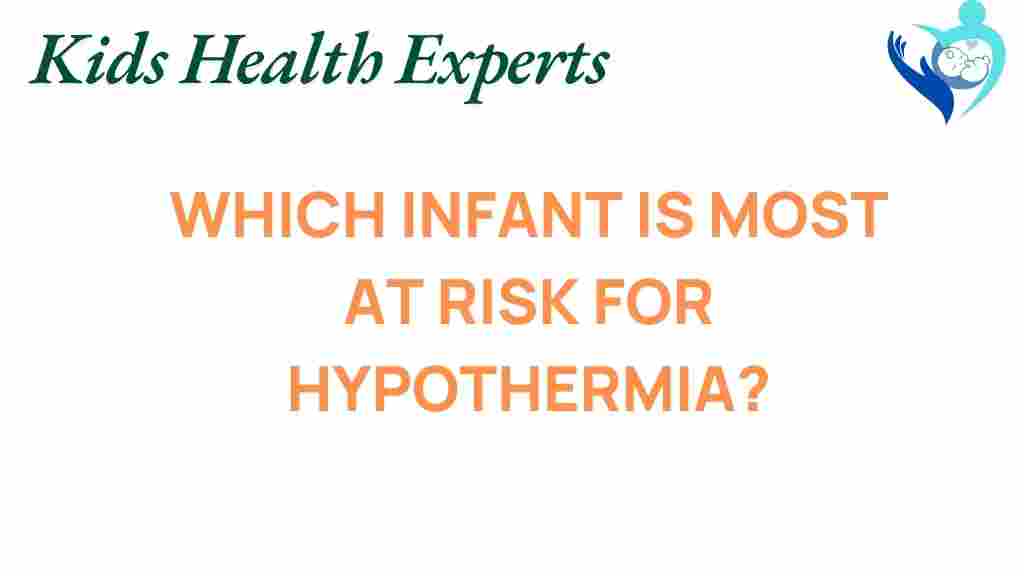Unraveling the Mystery: Which Infant is Most at Risk for Hypothermia?
Hypothermia is a serious condition that can affect infants, especially those who are vulnerable due to various factors. Understanding which infants are most at risk for hypothermia is essential for newborn care and pediatric safety. In this article, we will explore the risk factors for hypothermia in infants, the implications for infant health, and best practices for temperature regulation to ensure the safety and well-being of newborns.
Understanding Hypothermia in Infants
Hypothermia occurs when the body loses heat faster than it can produce it, leading to a dangerously low body temperature. For infants, particularly newborns, maintaining an appropriate body temperature is critical due to their limited ability to regulate temperature. Infants are more susceptible to cold exposure, which can lead to health vulnerabilities and serious complications.
Risk Factors for Hypothermia in Infants
Several risk factors can increase the likelihood of hypothermia in infants. Understanding these factors is vital for parents and caregivers to ensure proper neonatal care.
- Low Birth Weight: Infants with low birth weight (less than 5.5 pounds) have less insulating body fat, making them more susceptible to cold.
- Prematurity: Premature infants have immature physiological systems, including poor temperature regulation.
- Illness: Infants suffering from infections or other illnesses may struggle to maintain body temperature.
- Environmental Conditions: Exposure to cold environments, such as during winter months or in poorly heated rooms, increases the risk of hypothermia.
- Inadequate Clothing: Infants who are not dressed appropriately for the weather conditions are at a higher risk.
- Parental Factors: Caregivers who are unaware or uninformed about the risks of cold exposure may fail to take necessary precautions.
The Importance of Temperature Regulation
Temperature regulation is crucial in infant health. Newborns rely on their caregivers to maintain an optimal temperature. Here are some key points to consider:
- Normal Body Temperature: The normal body temperature for infants ranges from 97.7°F to 99.5°F (36.5°C to 37.5°C).
- Signs of Hypothermia: Symptoms may include cold skin, lethargy, poor feeding, and a weak cry.
- Body Fat and Surface Area: Infants have a higher surface area to volume ratio, which can lead to faster heat loss.
Best Practices for Newborn Care
To protect infants from hypothermia, caregivers should follow these best practices:
- Keep the Environment Warm: Ensure that the room temperature is warm enough, ideally between 68°F and 72°F (20°C to 22°C).
- Dress Appropriately: Dress infants in layers, using hats and blankets to retain heat.
- Skin-to-Skin Contact: Practice kangaroo care, which promotes warmth and bonding.
- Monitor for Signs: Regularly check the infant’s temperature and look for signs of cold stress.
- Educate Caregivers: Provide information on the risks of hypothermia and the importance of temperature regulation.
Step-by-Step Process: Keeping Your Infant Warm
Here’s a step-by-step guide to ensuring your infant stays warm and safe:
- Check the Room Temperature: Use a thermometer to ensure the room is warm enough.
- Dress Your Infant: Use a onesie, socks, and a hat. Consider adding a sleep sack for extra warmth.
- Hold Your Infant: Engage in skin-to-skin contact to share body heat.
- Use Blankets Wisely: Wrap your infant snugly in a light blanket, but avoid overheating.
- Regularly Monitor Temperature: Use a digital thermometer to check your infant’s temperature regularly.
Troubleshooting Tips for Hypothermia Risks
If you suspect your infant is at risk of hypothermia, consider the following troubleshooting tips:
- Reassess Clothing: Make sure your infant is dressed appropriately for the current weather conditions.
- Evaluate the Environment: Check for drafts or cold areas in the room.
- Seek Medical Attention: If your infant shows signs of hypothermia, contact a healthcare professional immediately.
- Educate Yourself: Stay informed about infant health and safety guidelines through reliable resources such as the CDC.
Conclusion
Understanding which infants are most at risk for hypothermia is critical for ensuring their health and safety. By recognizing the risk factors, practicing effective temperature regulation, and educating caregivers, we can significantly reduce the incidence of hypothermia in vulnerable infants. Always prioritize pediatric safety and be vigilant in monitoring your infant’s environment and clothing. For more information on neonatal care and infant health, consider visiting this resource.
Remember, taking proactive steps can make a significant difference in your infant’s well-being, ensuring a healthier start to life.
This article is in the category Conditions and created by KidsHealthExperts Team
